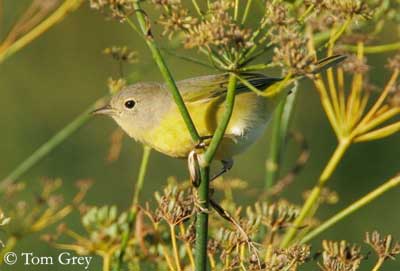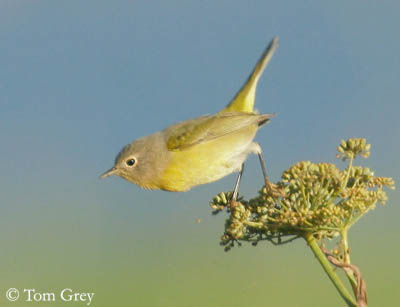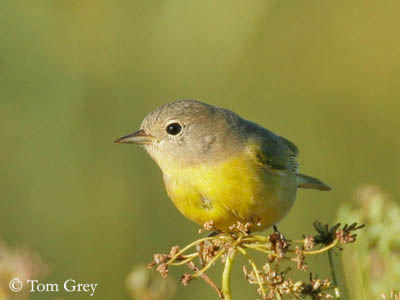
Nashville Warbler
Leiothlypis ruficapilla
Passeriforme Order – Parulidae Family
BIOMETRICS:
Length : 10-12 cm
Wingspan : 17-20 cm
Weight : 7-12 g
LONGEVITY: Up to 7 years
DESCRIPTION:
Nashville Warbler has grey head and olive upperparts. It has a bold white eye ring. It has yellow throat, breast and belly, with a white area between yellow belly and yellow undertail. Crown shows a rufous patch, not easy to see in field.
Eyes and legs are black. Bill is rather short, slender, nearly straight, and as deep as broad at the base.
Both sexes are similar, with female slightly duller.
Immature is similar to adult, but it has brownish wash on back, and whitish throat patch.
DIET:
Nashville Warbler feeds on insects, both adults and larvae, and caterpillars which are the majority of their diet. In nonbreeding range, it visits flowers, takes small berries and seeds, and gleans for small insects.
PROTECTION / THREATS / STATUS:
Nashville Warbler benefited of clearing of woodland, creating more second growth habitat.
Fr: Paruline à joues grises
All : Rubinfleck-Waldsänger
Esp : Chipe de Cabeza Gris
Ital: Beccavermi di Nashville
Nd: Nashvillezanger
Sd: Nashvilleskogssångare
Photographs by Tom Grey
His website:
Tom Grey's Bird Pictures
Text by Nicole Bouglouan
Sources:
A GUIDE TO THE BIRDS OF MEXICO AND NORTHERN CENTRAL AMERICA by Steve N. G. Howell, Sophie Webb - Oxford University Press - ISBN: 0198540124
BIRDS OF THE GREAT BASIN – by Fred A. Ryser - Univ of Nevada Pr -ISBN: 0874170796
FIELD GUIDE TO THE BIRDS OF NORTH AMERICA by National Geographic Society - National Geographic Society - ISBN: 0792274512
All About Birds (Cornell Lab of Ornithology)
What Bird-The ultimate Bird Guide (Mitchell Waite)
Wikipedia (Wikipedia, The Free Encyclopedia)
Bird Web (Seattle Audubon Society)

Western population called “Calaveras Warbler” is slightly brighter than eastern birds, with brighter yellow rump, more extensive white feathers on lower belly and slightly longer tail.
VOICE: SOUNDS BY XENO-CANTO
Nashville Warbler’s song is a series of high “see-weet” notes, and a lower short trill like “see-pit, see-pit, see-pit ti ti ti ti”. Usually, it has two distinct segments, with a pause between the phrases.
HABITAT:
Nashville Warbler is found in second growth woodlands, deciduous or mixed forests, with shrubby undergrowth.
Rocky Mountains and prairies form a barrier between the two forms of this species.
RANGE:
Nashville Warbler breeds in two distinct areas. Eastern range extends from Central Saskatchewan to Nova Scotia, southward to N Minnesota, Michigan and Pennsylvania.
Western range extends from SW Alberta to Central California.
It winters mainly in southern Mexico, but also in lowlands along California coasts.

BEHAVIOUR:
Nashville Warbler feeds in mixed-species flocks in fall, before and during migration. It searches for food in the foliage, flicking its tail frequently. It usually forages fairly low in trees or bushes, and males higher than females. It often finds its preys at tip of twigs and leaves.
Male stands erect and still while is uttering its song.
Nashville Warblers are monogamous during breeding season.
They migrate mostly at night. First year migrate birds along Atlantic coast, but adults tend to migrate along inland routes. They do not perform their whole migration in a single flight, but stopping sometimes.
FLIGHT:
Nashville Warbler has a short and light flight, similar to that of the other species of this genus.
REPRODUCTION:
Nashville Warbler’s nest is built by female. It is a small open cup located on the ground, usually in a brushy thicket in open woodland. Nest is in a low depression in moss, grass, ferns or under bushes. It is made with leaves, ferns, and bark strips, and lined with grass, hair and needles with a rim of moss. Sometimes, Nashville Warbler may use porcupine quills as nest material.
Female lays 4 to 5 white eggs spotted with brown. Incubation lasts about 11 to 12 days, by female. Male feeds female on the nest while incubates, and may take a turn at incubation as well. Young are fed by both parents. Altricial chicks fledge at 9 to 11 days after hatching.
This species produces one single brood per season.
